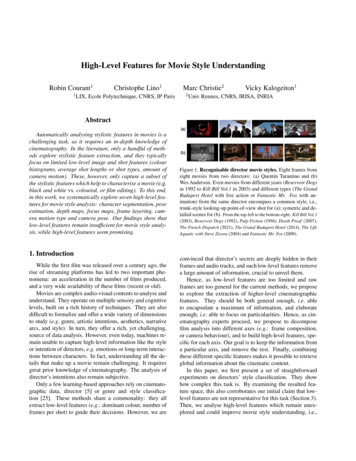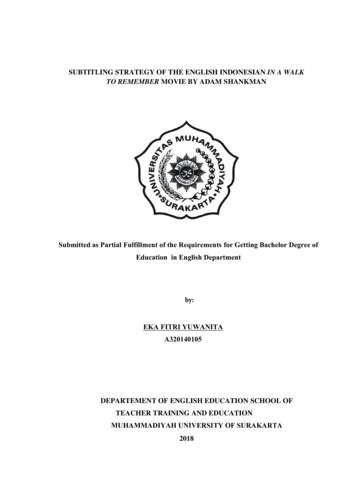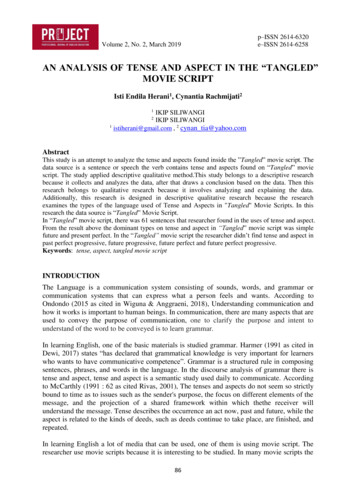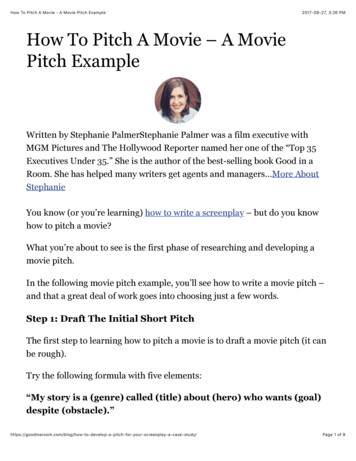
Transcription
High-Level Features for Movie Style UnderstandingRobin Courant11Christophe Lino1LIX, Ecole Polytechnique, CNRS, IP ParisMarc Christie22Vicky Kalogeiton1Univ Rennes, CNRS, IRISA, INRIAAbstractAutomatically analysing stylistic features in movies is achallenging task, as it requires an in-depth knowledge ofcinematography. In the literature, only a handful of methods explore stylistic feature extraction, and they typicallyfocus on limited low-level image and shot features (colourhistograms, average shot lengths or shot types, amount ofcamera motion). These, however, only capture a subset ofthe stylistic features which help to characterise a movie (e.g.black and white vs. coloured, or film editing). To this end,in this work, we systematically explore seven high-level features for movie style analysis: character segmentation, poseestimation, depth maps, focus maps, frame layering, camera motion type and camera pose. Our findings show thatlow-level features remain insufficient for movie style analysis, while high-level features seem promising.1. IntroductionWhile the first film was released over a century ago, therise of streaming platforms has led to two important phenomena: an acceleration in the number of films produced,and a very wide availability of these films (recent or old).Movies are complex audio-visual contents to analyse andunderstand. They operate on multiple sensory and cognitivelevels, built on a rich history of techniques. They are alsodifficult to formalize and offer a wide variety of dimensionsto study (e.g. genre, artistic intentions, aesthetics, narrativearcs, and style). In turn, they offer a rich, yet challenging,source of data analysis. However, even today, machines remain unable to capture high-level information like the styleor intention of directors, e.g. emotions or long-term interactions between characters. In fact, understanding all the details that make up a movie remain challenging. It requiresgreat prior knowledge of cinematography. The analysis ofdirector’s intentions also remain subjective.Only a few learning-based approaches rely on cinematographic data, director [5] or genre and style classification [25]. These methods share a commonality: they allextract low-level features (e.g.: dominant colour, number offrames per shot) to guide their decisions. However, we areFigure 1. Recognisable director movie styles. Eight frames fromeight movies from two directors: (a) Quentin Tarantino and (b)Wes Anderson. Even movies from different years (Reservoir Dogsin 1992 to Kill Bill Vol.1 in 2003) and different types (The GrandBudapest Hotel with live action or Fantastic Mr. Fox with animation) from the same director encompass a common style, i.e.,trunk-style looking-up point-of-view shot for (a); symetric and detailed scenes for (b). From the top-left to the bottom-right: Kill Bill Vol.1(2003), Reservoir Dogs (1992), Pulp Fiction (1994), Death Proof (2007),The French Dispatch (2021), The Grand Budapest Hotel (2014), The LifeAquatic with Steve Zissou (2004) and Fantastic Mr. Fox (2009).convinced that director’s secrets are deeply hidden in theirframes and audio tracks, and such low-level features removea large amount of information, crucial to unveil them.Hence, as low-level features are too limited and rawframes are too general for the current methods, we proposeto explore the extraction of higher-level cinematographicfeatures. They should be both general enough, i.e. ableto encapsulate a maximum of information, and elaborateenough, i.e. able to focus on particularities. Hence, as cinematography experts proceed, we propose to decomposefilm analysis into different axes (e.g.: frame composition,or camera behaviour), and to build high-level features, specific for each axis. Our goal is to keep the information froma particular axis, and remove the rest. Finally, combiningthese different specific features makes it possible to retrieveglobal information about the cinematic content.In this paper, we first present a set of straightforwardexperiments on directors’ style classification. They showhow complex this task is. By examining the resulted feature space, this also corroborates our initial claim that lowlevel features are not representative for this task (Section 3).Then, we analyse high-level features which remain unexplored and could improve movie style understanding, i.e.,
Table 1. Director classification results.frame layering and camera motion type (Section 4). Thiswork explores a promising avenue in movie style understanding, and paves the way for future research on this area.MethodPrecisionRandom12.77Weighted Random12.42ResNet-18 (scratch)35.93ResNet-18 (k700)51.17ResNet-50 (scratch)38.14ResNet-50 (k700)48.082. Related WorkCinematography is a well-studied field, both for analysis and synthesis purposes. As pointed by [19], many applications can benefit from automatic cinematic approaches(e.g. virtual production or interactive drama). Furthermore,movies and TV shows become more easily accessible, especially on the web, and just start to get exploited in computervision.Working with these video contents, [3] propose a multimodal person clustering algorithm, and [18] propose amethod to generate textual description of a clip. These contents are also exploited in more general video analysis tasks,as they provide examples of daily scenes. For instance, [22]learn social interactions from movies and [14] propose adataset for realistic human action recognition.Some works also focus on automatic cinematographyanalysis. [5, 25, 20] extract low-level features from visual, audio and textual modalities to tackle different cinematic tasks, e.g. director classification, genre classification,film rating prediction or production year prediction. Morerecently, large-scale annotated movie datasets such as [9]open the perspective for better cinematic analysis. [16] propose a supervised framework to classify the shot type (camera movement and scale), [17] propose a multimodal scenesegmentation method, and [10] propose to learn visual models from movie trailers. However, approaches focusing onthe analysis of film genre or directorial styles remain limited, probably due to a lack of data. Indeed, creating largedatasets of movies and TV shows requires to acquire allcopyrights. Such approaches also rely solely on low-levelvisual or audio features (e.g. colour histograms, shot lengthdistribution, voice spectrograms). To overcome these limitations, in this paper, we propose to explore the extractionand use of high-level features, enabling to retrieve moreglobal information on the directorial style of a movie.3. Low-Level Features in Director RecognitionGiven a set of directors and clips from their respective movies, director classification consists in associatingeach clip with its director. In this section, we propose asupervised approach to director classification on a dataset(CMD8) specifically designed for this task.Method. For classification, we rely on a 3D variant of theResNet architecture [7]. We take as input 16 raw frames, selected by splitting the video clips into chunks of 32 frames,which are then randomly 111.8912.4235.0249.1838.3444.78Mar4n ScorseseThe Last WaltzThe DepartedRagging BullAHer HoursStanley KubrickPaths of GloryDr. StrangeloveDavid FincherBenjamin Bu*onAlien 3Ethan CoenNo Country For Old MenJoel CoenThe Hudsucker ProxyThe Man Who Wasn’t ThereWoody AllenThe Purple Rose of CairoWes AndersonThe Darjeeling LimitedQuen4n Taran4noJackie BrownFigure 2. t-SNE visualization of feature embedding on CMD8.Clusters correspond to: (1) 1970s movies, (2) 1980s movies, (3)black and white movies, (4) 1990s movies and (5) 2000s movies.3.1. DatasetsCondensedMovies [1] is a corpus gathering more than1, 270 hours of around two minutes clips, taken fromYouTube, from more than 3, 600 movies. For each movie,the dataset contains several clips. Each clip depicts a keyscene of the movie and comes with semantic description ofthe scene, character face-tracks, and movie metadata.CMD8 (Condensed Movies Director 8) contains 24 hoursof clips from CondensedMovies. We pick all clips relatedto eight directors.3.2. Experimental ResultsMetrics. For evaluation, we use: Precision, Recall and F1score as the harmonic mean between precision and recall.Quantitative results. We test two approaches: (i) trainingfrom scratch, using random weight initialization; or (ii) using a model pre-trained on Kinetics-700 [4]. We also experiment with two ResNet depths: 18 and 50. For comparison,we also report results on two baselines: (a) a random classifier, and (b) a random weighted classifier (i.e.: 1 chance outof 8, weighted by the number of samples in the class.).Table 1 shows the results on CMD8. We observe thatResNet outperforms both baselines, resulting in precisionand recall of around 50%. However, we make the following two remarks. First, the shallowest architecture performsbetter than the deepest. Second, the performance margin be-
Figure 3. Frame layering pipeline. Raw frames are used to estimate depths maps, which are converted into a discrete set of layers.tween scratch and pre-trained configurations is small. Bothremarks are in contrast to the observations of the state ofthe art, where deeper models outperform shallow ones (e.g.,as in [7] for HMDB-51 [13]) and using models pre-trainedon Kinetics [4] doubles the performances. The first remarkshows that probably there are not enough training data; thesecond shows that this type of models with pre-training onaction datasets are not optimal for director classification,thus revealing the need for more elaborate methods.Feature visualization. To have an idea of criteria learnedby the network, Figure 2 displays the t-SNE [8] visualisation of the CMD8 test set. For each sample, we extract visual features learned by the ResNet-18 pre-trained on Kinetics 700. From this visualisation, we distinguish five clustersand characterize them by examining their movie characteristics: each cluster gathers movies from the same decade orin black and white. This would suggest that, using only rawframes, the network learns low-level visual features such asthe amount of blur, that highly characterizes the technicalevolution of the camera over the decades (film in contrastwith digital). It requires further investigation.Discussion. Our findings show that pre-training on largeaction datasets like Kinetics [4] is not necessarily suitablefor style analysis. Possible solutions for this would be toeither pre-train on movie datasets or to use other inputs. Asthe dataset is not large enough, models cannot extract easily all the information. While this lack of data is a possible reason of failure, our hypothesis is that the provision ofhigher-level features (which experts use to perform directorclassification) shall be explored.Figure 4. Camera motion detection pipeline. Consecutive rawframes are used to compute forward and backward optical flowsthat are converted to angle grids. Once flattened, angle grids arefed to a MLP that learns the camera motion.bined with the Hungarian algorithm [2].(b) Composition-based features are essential to understand the aesthetics of directors. In particular, the framecomposition is closely related to the complexity of a miseen-scene. We extract three composition-based features:depth estimation using [15], focus estimation with [6]and frame layering. Further, we propose a frame layering method that splits a frame into depth layers to retrievevarious frame composition levels, e.g. foreground, middleground or background.(c) Camera-based features are key markers of cinematographic style. They define characteristic camera behaviourin relation with scene contents. Moreover, the camera isthe eye of the audience. Therefore, we argue that understanding the camera behaviour helps to better understandthe director’s intentions. We extract two camera-based features: camera pose estimation in the toric space from [11]and camera motions. For the camera motion detection, webuild our own model that learns six camera motion types.We propose the study of seven high-level features forfilm style understanding in cinematography, grouped intothree categories. We describe our proposed pipelines fortwo of them: frame layering and camera motion detection.Frame layering has never been exploited before, eventhough it is a spontaneous process humans do when looking at an image. In this work, we propose a frame layering approach that extracts a layer map where pixels aregrouped into depth layers (e.g. foreground, middleground,background). Figure 3 shows our extraction pipeline. Givena sequence of consecutive frames, we first compute theirdepth maps using [15]. We then cluster pixels through a Kmeans. The optimal number of clusters is computed withthe elbow method [12]. To improve the temporal smoothness of computed maps (NN-based depth estimators are inherently noisy), we smooth the optimal number of clustersfor consecutive depth maps using a max pooling slidingwindow. In the end, we compute a final cluster map usingthe smoothed optimal number of clusters.(a) Character-based features enable tracking what the director is focusing on, as characters are very often the centre of the story and of the visual content. We extract twocharacter-based features: character segmentation usingDetectron2 [24] and pose estimation using DOPE [23].Both are tracked along each shot with a Kalman filter com-Camera Motion is the way the camera moves in space andcreates dynamics within consecutive frames. Typical examples encompass static shots, horizontal movements (panand truck), vertical movements (boom and tilt), depth movements (zoom, pull-out and push-in) and rotational movement (roll). In this work, we propose a pre-processing4. High-Level Features in Movie Style Analysis
Figure 5. Examples of frame layering. (top) Raw frames,and (bottom) layer maps with overlayed character segmentationmasks. Our pipeline (a), (b): correcly predicts the number of layers and is consistent over time. (c), (d): incorrectly predicts a newlayer (purple) when a character moves towards the background.Figure 6. Examples of camera motion detections. (a) Correctlypredicted zoom motion. (b) Failure case of a mixed horizontal andvertical motion incorrectly predicted as zoom.Table 2. Motion classification results.and detection pipeline, learning to differentiate among them(Figure 4). Given two consecutive frames, we first computetheir forward and backward optical flows using [21]. Then,we compute the flows’ angles, and average pool them to obtain the angle grids. We finally flatten and concatenate thebackward and forward angle grids and feed them to a twolayer MLP that learns to classify them. Behind this detection, we aim to estimate the extrinsic 6 degrees of freedomof the camera. Note that at training we merge some motionsinto more general groups (e.g. horizontal, vertical, depthmotions). In practice, it is difficult to distinguish them.5. Experiments5.1. Experiments on Frame LayeringQuantitative results. Figure 5 displays some results whenapplying our pipeline on several video sequences. (a, b)show an example where layering is successful, i.e., with theright number of clusters and good temporal continuity. (c,d) show a failure case: while the central character is transitioning from foreground to background, our method incorrectly generates a new layer (in purple, top right of layermap (d)). We argue that this lack of robustness results fromboth the noisy depth map output and the way we choose thenumber of clusters (which seems suboptimal). Overall, bothexamples show the efficacy of our layering method for unseen and challenging (dark as in (a), cluttered in (c)) scenes.5.2. Experiments on Camera Motion DetectionMotionSet is a dataset we created with camera motion clipsfrom YouTube1 . We split each shot into sub-clips withsingle camera motion, resulting in 75 clips with motions:static, horizontal (pan and trucking), vertical (boom, tilt),depth (zoom, pull out and push in) and rotational (roll).Quantitative results. We train and test our camera motiondetector on MotionSet. Table 2 reports the results. For comparison, we also evaluate the Random and Weighted Random baselines. Our model significantly outperforms both1 1.26Weighted Random18.62Ours98.47RecallF121.70 19.6218.49 18.5295.50 96.81baselines, and it reaches high performances, i.e., 96.81% ofF1 score and almost perfect precision 98.47%. This showsthat for simple and short sequences, our model correctlyrecognizes the camera motions.Qualitative results. Figure 6 displays some results whenapplying our detector on several video sequences. (a) showsan example of zoom camera motion correctly predicted; (b)shows a failure case, where a mixed horizontal and verticalmotion is incorrectly predicted as a zoom. We observe thatin most cases, the detector recognizes the motion correctly.However, we are aware that our dataset is probably not diverse enough. In addition, when using our motion detectionin the wild, we observe that it is not robust to combined motion (e.g. mixing vertical with horizontal camera motion).In this case, our model typically fails, most likely becauseit is not trained with such challenging samples.6. ConclusionIn this paper, we perform straightforward experiments ondirector style classification, and show that the performancesare not satisfying when solely relying on raw frames. Wethen propose and analyse a non-exhaustive list of high-levelfeatures that we believe could improve such classificationtasks. We finally show the first results for frame layeringand camera motion detection, which seem promising forcinematographic applications.In the future, we plan to consider more features. Forinstance, we could use audio-based features (e.g. activespeaker) or exploit soundtrack analysis. Finally, a longerterm objective would be to explore latent representationslearnt by our models (i) to understand what they learnt andwhich features are important; and (ii) to exploit these representations for various applications to help filmmakers.
References[1] Max Bain, Arsha Nagrani, Andrew Brown, and Andrew Zisserman. Condensed movies: Story based retrieval with contextual embeddings. In Proc. Asian Conf. on Computer Vision, 2020.[2] Alex Bewley, ZongYuan Ge, Lionel Ott, Fabio Ramos, andBen Upcroft. Simple online and realtime tracking. CoRR,2016.[3] Andrew Brown, Vicky Kalogeiton, and Andrew Zisserman.Face, body, voice: Video person-clustering with multiplemodalities. arXiv preprint arXiv:2105.09939, 2021.[4] Joao Carreira, Eric Noland, Chloe Hillier, and Andrew Zisserman. A short note on the kinetics-700 human actiondataset. arXiv preprint arXiv:1907.06987, 2019.[5] Priyankar Choudhary, Neeraj Goel, and Mukesh Saini. Amultimedia based movie style model. In 2019 IEEE International Conference on Multimedia & Expo Workshops(ICMEW), 2019.[6] Xiaodong Cun and Chi-Man Pun. Defocus blur detection viadepth distillation. In ECCV, 2020.[7] Kensho Hara, Hirokatsu Kataoka, and Yutaka Satoh. Canspatiotemporal 3d cnns retrace the history of 2d cnns andimagenet? In CVPR, 2018.[8] Geoffrey Hinton and Sam Roweis. Stochastic neighbor embedding. In NeurIPS, 2002.[9] Qingqiu Huang, Yu Xiong, Anyi Rao, Jiaze Wang, andDahua Lin. Movienet: A holistic dataset for movie understanding. In ECCV, 2020.[10] Qingqiu Huang, Yuanjun Xiong, Yu Xiong, Yuqi Zhang, andDahua Lin. From trailers to storylines: An efficient way tolearn from movies. arXiv preprint arXiv:1806.05341, 2018.[11] Hongda Jiang, Bin Wang, Xi Wang, Marc Christie, andBaoquan Chen. Example-driven virtual cinematography bylearning camera behaviors. ACM Transactions on Graphics(TOG), 2020.[12] Trupti M Kodinariya and Prashant R Makwana. Review ondetermining number of cluster in k-means clustering. International Journal, 2013.[13] Hildegard Kuehne, Hueihan Jhuang, Estı́baliz Garrote,Tomaso Poggio, and Thomas Serre. Hmdb: a large videodatabase for human motion recognition. In ICCV, 2011.[14] Ivan Laptev, Marcin Marszalek, Cordelia Schmid, and Benjamin Rozenfeld. Learning realistic human actions frommovies. In CVPR, 2008.[15] Zhengqi Li, Tali Dekel, Forrester Cole, Richard Tucker,Noah Snavely, Ce Liu, and William T Freeman. Learningthe depths of moving people by watching frozen people. InCVPR, 2019.[16] Anyi Rao, Jiaze Wang, Linning Xu, Xuekun Jiang, QingqiuHuang, Bolei Zhou, and Dahua Lin. A unified frameworkfor shot type classification based on subject centric lens. InECCV, 2020.[17] Anyi Rao, Linning Xu, Yu Xiong, Guodong Xu, QingqiuHuang, Bolei Zhou, and Dahua Lin. A local-to-global approach to multi-modal movie scene segmentation. In CVPR,2020.[18] Anna Rohrbach, Atousa Torabi, Marcus Rohrbach, NiketTandon, Christopher Pal, Hugo Larochelle, Aaron Courville,and Bernt Schiele. Movie description. International Journalof Computer Vision, 2017.[19] Rémi Ronfard. Film directing for computer games and animation. In Computer Graphics Forum. Wiley Online Library,2021.[20] Jussi Tarvainen, Mats Sjöberg, Stina Westman, Jorma Laaksonen, and Pirkko Oittinen. Content-based prediction ofmovie style, aesthetics, and affect: Data set and baseline experiments. IEEE Transactions on Multimedia, 2014.[21] Zachary Teed and Jia Deng. Raft: Recurrent all-pairs fieldtransforms for optical flow. In ECCV, 2020.[22] Paul Vicol, Makarand Tapaswi, Lluis Castrejon, and SanjaFidler. Moviegraphs: Towards understanding human-centricsituations from videos. In CVPR, 2018.[23] Philippe Weinzaepfel, Romain Brégier, Hadrien Combaluzier, Vincent Leroy, and Grégory Rogez. Dope: Distillation of part experts for whole-body 3d pose estimation inthe wild. In ECCV, 2020.[24] Yuxin Wu, Alexander Kirillov, Francisco Massa, Wan-YenLo, and Ross Girshick. Detectron2. https://github.com/facebookresearch/detectron2, 2019.[25] Federico Álvarez, Faustino Sánchez, Gustavo HernándezPeñaloza, David Jiménez, José Manuel Menéndez, andGuillermo Cisneros. On the influence of low-level visualfeatures in film classification. PLOS ONE, 2019.
ResNet architecture [7]. We take as input 16 raw frames, se-lected by splitting the video clips into chunks of 32 frames, which are then randomly sampled. Table 1. Director classification results. Method Precision Recall F1 Random 12.77 12.86 11.89 Weighted Random 12.42 12.42 12.42 ResNet-











